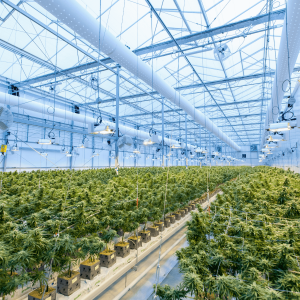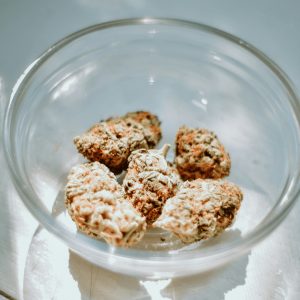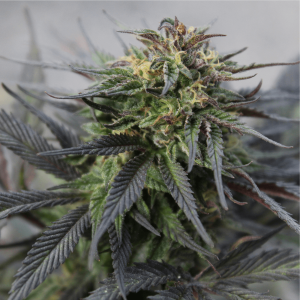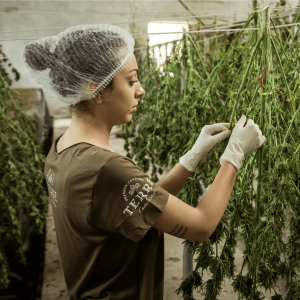Bud rot, also known as botrytis cinerea, is a pesky fungal disease that can wreak havoc on your cannabis crops, particularly during the flowering stage. For growers, it’s a real concern because it not only damages the buds but can also spread quickly, jeopardizing an entire harvest if left unchecked.
Understanding bud rot is essential for maintaining healthy plants and ensuring you reap the rewards of your hard work. In this blog, we’ll dive into what causes bud rot, signs to look out for, and how to prevent it from taking over. Plus, we’ll cover the best practices for managing your plants in order to secure a successful harvest.
This is step one to keeping your crops bud rot-free. Let’s get started!
What is Bud Rot?
Bud rot, or botrytis cinerea, is a type of gray mold that can devastate cannabis plants, particularly during the flowering phase when the buds are most vulnerable.
This fungal disease thrives in damp, humid conditions, making it a common threat for growers who might find themselves battling fluctuating weather patterns. While cannabis is primarily at risk, bud rot attacks other plants like grapes, tomatoes, and certain flowers.
Understanding the pathogen’s lifecycle is crucial; botrytis starts as tiny spores that spread through the air and can quickly colonize damp plant material, forming a cycle of infection that poses a significant challenge for both novice and experienced growers.

Signs and Symptoms
Detecting cannabis bud rot early can mean the difference between saving your crop or losing it entirely. One of the first signs to look for is the appearance of brown, mushy spots on the bud itself, often accompanied by a grayish fuzz — that’s the mold spores taking hold.
As the infection spreads, you may notice a decline in the overall health and vigor of your plants, with leaves wilting or turning yellow as they struggle to cope.
Other warning signs include a musty smell emanating from the affected buds and a general lack of resin production. Keeping an eye out for these indicators can help you catch bud rot before it wreaks havoc on your harvest.
Causes and Risk Factors
Bud rot thrives in environments where humidity levels are too high, typically above 60 percent, combined with warm temperatures and poor airflow. These conditions create a perfect breeding ground for the fungal spores, allowing them to flourish and spread quickly.
However, environmental factors aren’t the only culprits; nutritional deficiencies — such as inadequate levels of potassium or phosphorus — and improper watering practices can weaken plant defenses, making them more susceptible to infection.
By identifying and managing these risk factors, you can help protect your crops from the dangers of bud rot and ensure a healthier, more robust harvest.

Bud Rot Prevention Strategies
Keeping bud rot at bay is all about creating the right environment for your plants and staying proactive with your care routine.
Here are some best practices for preventing bud rot:
Optimal Growing Conditions and Maintaining Humidity
- Monitor Humidity Levels: Aim to keep humidity levels below 60% during the flowering stage. Using a hygrometer can help you keep tabs on the moisture in the air.
- Control Temperature: Maintain temperatures around 20-26°C (68-78°F) during the day and slightly cooler at night. This range helps deter fungal growth.
- Increase Airflow: Good airflow is essential. Use fans or oscillating air circulation to keep air moving around your plants, reducing moisture buildup.
- Water Smartly: Water your plants early in the day so they have time to dry before nightfall, which helps minimize humidity levels at night.
The Importance of Proper Pruning and Airflow
Proper pruning and airflow are crucial for healthy plant growth. Regularly trimming away dead plant material (such as leaves, for example) and any overcrowded growth enhances light penetration and airflow, promoting healthier development while minimizing moist areas where mold can thrive.
Additionally, spacing your plants appropriately is important; giving them enough room to breathe and avoiding overcrowding ensures that air circulates freely between them.
Recommended Products for Prevention (fungicides, sprays)
- Fungicides: Look for products that contain active ingredients like potassium bicarbonate or sulfur, which can be effective against botrytis.
- Neem Oil: A natural pest control solution that also helps deter fungal growth.
- Organic Sprays: Consider using sprays formulated with essential oils, as they can help prevent bud rot without harsh chemicals.
- Mycorrhizal Fungi: Add these beneficial fungi to your soil to enhance plant health and resilience against diseases.
By implementing these strategies, you’ll create a healthier environment for your plants and significantly reduce the risk of bud rot taking hold.

Treatment Options
If you catch bud rot in your plants, don’t panic! There are steps you can take to treat the affected areas and help your crops bounce back. Here’s a simple guide to get you started:
Step-by-Step Guide for Treating Affected Plants
- Identify the Infected Areas: Take a close look at your plants and spot any brown, mushy buds or areas where the gray mold is visible.
- Remove Infected Buds: Using clean, sharp scissors, carefully cut away the infected buds and any nearby foliage that shows signs of mold. Make sure to disinfect your scissors with rubbing alcohol after each cut to prevent spreading spores.
- Dispose of Infected Material Safely: Don’t just toss those infected buds in the compost or regular trash! Seal them in a plastic bag and throw them away to prevent any spores from reinfecting your garden.
- Improve Growing Conditions: After removing the affected parts, assess the growing environment. Lower humidity, improve airflow, and adjust watering practices as previously discussed to help your remaining plants heal.
Note that if you detect bud rot on your infected plants, it’s entirely okay to harvest plants early depending on their stage of growth.
Use of Fungicides and When to Apply Them
If the infection is severe or widespread, you might need to turn to fungicides for additional help. When choosing a fungicide, look for products labeled specifically for botrytis. Apply them as soon as you notice the infection and follow the manufacturer’s instructions for dosage and frequency.
It’s best to apply fungicides ideally just before any signs of bud rot appear and during the early stages of infection, as this can help prevent further spread.
Natural Remedies and Alternative Treatments
For those who prefer eco-friendly options, there are several natural remedies you can try:
- Neem Oil: Mix neem oil with water and spray it onto the infected areas. It’s great for fighting off fungal diseases while being gentle on your plants.
- Baking Soda Solution: A simple mixture of water and baking soda can create an inhospitable environment for fungi. Spray it on your plants but avoid overdoing it to prevent leaf burn.
- Essential Oils: Certain essential oils, like tea tree or oregano oil, have natural antifungal properties. Dilute a few drops in water and apply it to the affected areas.
Remember, prevention is always the best strategy, but if you do find bud rot, taking these steps will help you manage it effectively.

Bud Rot vs. Other Plant Issues
It’s easy to confuse bud rot with other pesky plant problems like powdery mildew and grey mold, but each has its own set of telltale signs.
Bud rot often appears as brown, mushy areas on the cannabis buds, which can feel soggy to the touch, indicating the plant is rotting from the inside out. In contrast, powdery mildew tends to present as a white, powdery substance on leaves and can disrupt healthy growth, but it does not cause the same mushiness in buds.
Grey mold resembles bud rot but usually has a fuzzy, grey appearance and can spread to other parts of the plant. To distinguish between these issues, closely inspect your plants: check for the characteristic symptoms — mushy buds for bud rot, white powder for powdery mildew, and grey fuzz for grey mold.
By recognizing these differences, you can tackle the right problem with the appropriate solution, keeping your plants healthy and thriving.
Recovery Tips for Affected Plants
Once the immediate threat of bud rot has been managed, it’s time to focus on helping your plants recover and thrive again.
Start by providing extra care to the remaining healthy buds; ensure they’re receiving adequate light and nutrients to promote new growth. A gentle feeding with a balanced fertilizer can support this rejuvenation process.
As your plants begin to bounce back, keep a close eye on them—monitoring for any signs of stress or new fungal issues is crucial. Regularly check the moisture levels in the air and soil, adjusting your watering practices as needed to prevent another bout of sogginess.
With a little patience and attentive care, your plants can overcome this setback and continue to flourish in your garden!
When to Seek Professional Help
Sometimes our green thumb just isn’t enough, and that’s perfectly okay! There are signs that might indicate it’s time to call in the pros. If you notice that your plants are showing persistent symptoms despite your best efforts or if you have multiple plants exhibiting issues at once, it’s a good idea to seek professional help. Other red flags include sudden and severe wilting, unexplained leaf drop, or any strange growth patterns that don’t seem normal for your plant’s species.
For resources, consider reaching out to local garden centers, horticultural societies, or extension services. Many universities offer plant health clinics where you can get expert advice. Additionally, there are online forums and communities dedicated to plant care, where you can connect with experienced gardeners and professionals who can provide guidance specific to your situation.
Don’t hesitate to ask for help; sometimes a fresh set of eyes can make all the difference in bringing your plants back to life!

Conclusion
Addressing bud rot is essential not just for saving affected plants but also for ensuring the overall health of your garden. By tackling this issue promptly, you’re giving your plants the best chance to recover and thrive.
Remember, being vigilant and proactive in your plant care can prevent problems before they start, leading to a more successful growing season. Regularly inspecting your plants, adjusting their environment, and employing both preventive measures and treatments will keep your garden flourishing.
So, stay engaged, keep learning, and enjoy the journey of nurturing your green friends! Happy gardening!
Frequently Asked Questions
1. Can bud rot buds be saved?
In some cases, if bud rot is caught early enough, you might be able to save the healthy parts of the plant. Carefully trim away any affected buds and improve the plant’s growing conditions. With a bit of extra care, such as ensuring proper airflow and humidity levels, your remaining buds may bounce back.
2. What is the cause of bud rot?
Bud rot is primarily caused by excess moisture and high humidity, which creates the perfect environment for fungi like Botrytis cinerea to thrive. Poor air circulation and overcrowding with outdoor plants can also contribute to creating these conditions, leading to infections in your plant buds.
3. What does bud rot look like on buds?
Bud rot typically manifests as brown, mushy areas on the buds, which may feel soggy to the touch. Infected buds often appear wilted or decayed, and you might notice a foul smell as the rot progresses. Catching these signs early is key to managing the problem effectively.
4. What temperature kills bud rot?
Bud rot thrives in warm, humid conditions, but temperatures below 50°F (10°C) can slow down or inhibit the growth of the fungi responsible for the rot. Maintaining a cooler, dry environment can help prevent bud rot from taking hold in the first place.

 Rewards
Rewards




